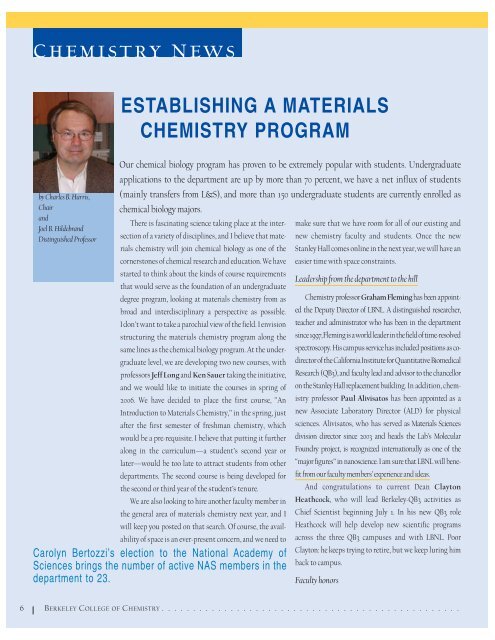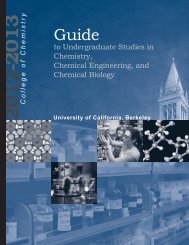Newsjournal body.qxp - College of Chemistry - University of ...
Newsjournal body.qxp - College of Chemistry - University of ...
Newsjournal body.qxp - College of Chemistry - University of ...
Create successful ePaper yourself
Turn your PDF publications into a flip-book with our unique Google optimized e-Paper software.
<strong>Chemistry</strong> News<br />
by Charles B. Harris,<br />
Chair<br />
and<br />
Joel B. Hildebrand<br />
Distinguished Pr<strong>of</strong>essor<br />
ESTABLISHING A MATERIALS<br />
CHEMISTRY PROGRAM<br />
Our chemical biology program has proven to be extremely popular with students. Undergraduate<br />
applications to the department are up by more than 70 percent, we have a net influx <strong>of</strong> students<br />
(mainly transfers from L&S), and more than 150 undergraduate students are currently enrolled as<br />
chemical biology majors.<br />
There is fascinating science taking place at the intersection<br />
<strong>of</strong> a variety <strong>of</strong> disciplines, and I believe that materials<br />
chemistry will join chemical biology as one <strong>of</strong> the<br />
cornerstones <strong>of</strong> chemical research and education. We have<br />
started to think about the kinds <strong>of</strong> course requirements<br />
that would serve as the foundation <strong>of</strong> an undergraduate<br />
degree program, looking at materials chemistry from as<br />
broad and interdisciplinary a perspective as possible.<br />
I don’t want to take a parochial view <strong>of</strong> the field. I envision<br />
structuring the materials chemistry program along the<br />
same lines as the chemical biology program. At the undergraduate<br />
level, we are developing two new courses, with<br />
pr<strong>of</strong>essors Jeff Long and Ken Sauer taking the initiative,<br />
and we would like to initiate the courses in spring <strong>of</strong><br />
2006. We have decided to place the first course, “An<br />
Introduction to Materials <strong>Chemistry</strong>,” in the spring, just<br />
after the first semester <strong>of</strong> freshman chemistry, which<br />
would be a pre-requisite. I believe that putting it further<br />
along in the curriculum—a student’s second year or<br />
later—would be too late to attract students from other<br />
departments. The second course is being developed for<br />
the second or third year <strong>of</strong> the student’s tenure.<br />
We are also looking to hire another faculty member in<br />
the general area <strong>of</strong> materials chemistry next year, and I<br />
will keep you posted on that search. Of course, the availability<br />
<strong>of</strong> space is an ever-present concern, and we need to<br />
Carolyn Bertozzi’s election to the National Academy <strong>of</strong><br />
Sciences brings the number <strong>of</strong> active NAS members in the<br />
department to 23.<br />
make sure that we have room for all <strong>of</strong> our existing and<br />
new chemistry faculty and students. Once the new<br />
Stanley Hall comes online in the next year, we will have an<br />
easier time with space constraints.<br />
Leadership from the department to the hill<br />
<strong>Chemistry</strong> pr<strong>of</strong>essor Graham Fleming has been appointed<br />
the Deputy Director <strong>of</strong> LBNL. A distinguished researcher,<br />
teacher and administrator who has been in the department<br />
since 1997, Fleming is a world leader in the field <strong>of</strong> time-resolved<br />
spectroscopy. His campus service has included positions as codirector<br />
<strong>of</strong> the California Institute for Quantitative Biomedical<br />
Research (QB3), and faculty lead and advisor to the chancellor<br />
on the Stanley Hall replacement building. In addition, chemistry<br />
pr<strong>of</strong>essor Paul Alivisatos has been appointed as a<br />
new Associate Laboratory Director (ALD) for physical<br />
sciences. Alivisatos, who has served as Materials Sciences<br />
division director since 2003 and heads the Lab’s Molecular<br />
Foundry project, is recognized internationally as one <strong>of</strong> the<br />
“major figures” in nanoscience. I am sure that LBNL will benefit<br />
from our faculty members’ experience and ideas.<br />
And congratulations to current Dean Clayton<br />
Heathcock, who will lead Berkeley-QB3 activities as<br />
Chief Scientist beginning July 1. In his new QB3 role<br />
Heathcock will help develop new scientific programs<br />
across the three QB3 campuses and with LBNL. Poor<br />
Clayton: he keeps trying to retire, but we keep luring him<br />
back to campus.<br />
Faculty honors<br />
6 BERKELEY COLLEGE OF CHEMISTRY . . . . . . . . . . . . . . . . . . . . . . . . . . . . . . . . . . . . . . . . . . . . . . . .




